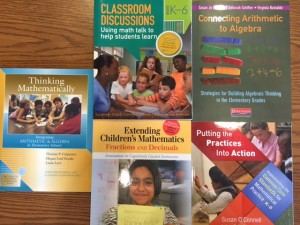Today we began by making vocabulary posters for the terms proportion, x-intercept, y-intercept, linear relationship, and slope. Here are the directions for that activity (also included on the “PMI Strategies for HW Review” document in Google folder – look under “Gallery Walk”):
Using large posters, put one vocabulary term per sheet. Arrange the posters around the room. Give each student a set of small post-it notes. Have students visit each post-it, read what others have written, and add an idea, example, concept, etc. about that term. Once that process is complete, assign a small group of students to each poster and ask them to make categories out of the small sticky notes and be ready to talk about their categories as well as any sticky notes that they have a question about mathematical validity. Discuss the terms as a whole group.
We then reviewed the homework by putting the answers on the document camera.
We resumed our discussion of the Currency Conversion with Exchange Fee from yesterday afternoon. Those solutions are now available in the Google Drive folder. Problem 12 provided an opportunity to discuss algebra’s strategic advantage as a tool: equation-solving skills provide an efficient and precise method to solve inverse problems. We also explored the algebra behind finding the equation of the inverse relationship (given E, find D), and how one version of the formula can be manipulated to fall into the format y=[number]*x+[number]. With a computer doing the graphing for us, we could quickly manipulate those two numbers to see how changing those numbers changed the picture.
We then used that discussion to segue into a discussion on the formal concepts of “slope,” “y-intercept,” and “x-intercept.” Andrew discussed a few misconceptions that he and Matt spotted on the posters from earlier.
We broke from that discussion to dive back into problem-solving, this time with the Burning the Candle problem. Andrew rewrote the original version to remove scaffolding, which opened the question up to exploration and encouraged solvers to use methods that made the most sense to them.
After lunch, we talked more about funneling and focusing questions, with Fran handing out an example of 2 conversations between Ms. Jones and Li – one where Ms. Jones uses a funneling pattern and one where she uses a focusing pattern. Then at their tables, teachers talked about their pedagogy homework – what they learned about their own questioning patterns. We switched gears and spent the last 25 minutes of the pedagogy time to find problems in textbooks that support students’ “floating capacity” for doing/undoing processes, rate, proportional reasoning, linear relationships, using multiple representations.
After the pedagogy discussion, we returned to extract the “big ideas” from the Candle problem. The graph of height over time showed a line with negative slope, which was borne out by both the calculations involved and the geometry. We saw how there were multiple choices of how to measure time: one can measure with x=0 representing midnight, 1am, 10:30pm (when the candle was list), or other times. One could also measure x in hours or half-hours or minutes. It was found that letting x representing “hours after midnight” (e.g., x=0 is midnight, x=1 is 1am) provided a convenient way to converting between values of x and clock times.
We then began exploring “What isn’t a linear relations?” This is intended to help isolate important (and incidental) features of linear relations and proportions.
Pedagogy Homework
1.Read Principles to Action, the section titled “Access and Equity” (p. 59-69)
2. Finish the activity we started in class: Using your textbook or curriculum guide, identify content at your grade level that supports the “floating capacity” for doing/undoing processes, rate, proportional reasoning, linear relationships, using multiple representations.Transfer problems to a piece of paper.
Math Homework
1. Return to the Kayaking Problem, Film Developing Problem (the original, not the variants), Currency Conversion without Exchange Fee, and Currency Conversion with Exchange Fee. Each involved comparing linear relationships. For each line involved describe each mathematical idea in terms of the original scenario. Specify units.
- The slope of the line
- The y-intercept of the line
- The x-intercept of the line
- The inverse relationship
2. Complete “What isn’t a linear relationship?”





